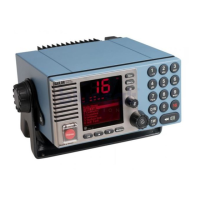
Do you have a question about the Sailor RT5022 VHF DSC and is the answer not in the manual?
| Channel Spacing | 25 kHz |
|---|---|
| Output Power | 25 W / 1 W |
| Display | LCD |
| Weight | 1.5 kg |
| GPS Interface | NMEA 0183 |
| Operating Temperature | -15°C to +55°C |
| DSC Class | Class D |
| Channels | All international maritime VHF channels |
Provides information for the daily user of the system, including installation and distress procedures.
Lists and defines acronyms and technical terms used throughout the manual for clarity.
Details RF exposure hazards and instructions for safe radio operation, including antenna placement.
Outlines the steps for initiating a Mayday call and acknowledging DSC distress alerts.
Explains how to turn the VHF unit on and off, and the behavior of connected devices.
Describes how to use the handset for transmitting and receiving calls on the working channel.
Guides the user on how to respond when their call name is heard on Channel 16.
Details the procedure for initiating a radiotelephone call, preferably via DSC.
Explains how to adjust the volume for the loudspeaker using the volume control.
Describes how to adjust the volume for the handset earpiece via the menu.
Explains how to adjust the squelch level for noise suppression.
Details how to select channels using the numeric keypad or navigation buttons.
Explains the dual watch mode for scanning priority channels while listening to a working channel.
Describes the facility to replay the last 90 seconds of received voice data.
Explains how to adjust the display and keypad backlight intensity.
Details how to adjust the display contrast for optimal viewing angle.
Guides on navigating the menu system for DSC functionality.
Explains how incoming DSC calls are indicated and displayed.
Details how DSC calls are initiated from the DSC Call Menu.
Procedure for calling a ship station via DSC, including suggesting a working channel.
Procedure for calling a shore station via DSC, requiring shore MMSI.
Explains making direct phone calls to PSTN via coast stations.
Procedure for calling a group of ships using DSC.
Guides on composing distress, urgency, and safety calls via the emergency menu.
Explains how to access and view received and transmitted DSC messages.
Describes how the VHF behaves after power interruptions of varying durations.
Covers how volume settings are stored after power off.
Details how to program squelch levels for individual channels.
Explains how to select different country regions for channel tables.
Details how private channels are programmed and selected.
Explains the operation of duplex channels on RT5022 and RT5020 models.
Explains the ATIS function for inland waterways and its programming.
Describes how to select between low (1W) and high power transmission.
Explains how to scan multiple channels, including all or selected channels.
Details how to configure user-defined scan tables.
Explains the importance and programming of the vessel's MMSI number for DSC.
Details how to configure and manage group MMSI numbers for group calls.
Describes how different call types are indicated by various ringing tones.
Explains how the system suggests a working channel for routine calls.
Details the features and management of the contact list for DSC calls.
Describes various settings applicable to different DSC call types.
Explains critical assumptions and decisions for DSC functionality not always visible.
Covers operator-controlled settings not described elsewhere, like idle display and language.
Explains the privacy mode for secure conversations, requiring a CU5000 unit.
Details the voice scrambling option, its activation via PIN code, and usage.
Explains how errors and warnings are logged for later review and analysis.
Provides guidance for identifying and resolving potential issues with the VHF system.
Describes how to perform self-tests on the unit's interface, display, and LEDs.
Details the features and operation of the CU5000 semi-functional control unit.
Explains the functionality of the Alarm Panel AP4365 when connected to the VHF.
Describes the optional printer for printing DSC messages and logs.
Lists international VHF channels, frequencies, and simplex/duplex modes.
Lists US VHF channels, frequencies, and simplex/duplex modes, including notes on usage.
Lists BI (Inland waterways) VHF channels, frequencies, and modes, with specific notes.
Lists CA (Canadian) VHF channels, frequencies, and modes, with specific notes.
Provides diagrams and dimensions for mounting the VHF unit with brackets.
Specifies safe distances for VHF components to avoid compass deviation.
Details the various connectors and ports on the rear of the VHF unit.
Specifies the required DC voltage and power ratings for VHF installation.
Provides guidelines for installing VHF and DSC antennas, including placement and cable types.
Covers channel tables, private channels, spacing, contact list, scanning, and replay features.
Lists technical standards and parameters for DSC operation and protocols.
Provides detailed technical specifications for the RT5022 model.
Provides detailed technical specifications for the RT5020 model.